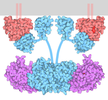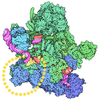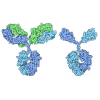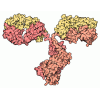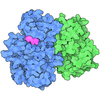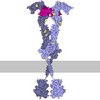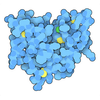+ Open data
Open data
- Basic information
Basic information
| Entry | Database: PDB / ID: 8tu6 | |||||||||||||||||||||||||||||||||||||||||||||
|---|---|---|---|---|---|---|---|---|---|---|---|---|---|---|---|---|---|---|---|---|---|---|---|---|---|---|---|---|---|---|---|---|---|---|---|---|---|---|---|---|---|---|---|---|---|---|
| Title | CryoEM structure of PI3Kalpha | |||||||||||||||||||||||||||||||||||||||||||||
 Components Components |
| |||||||||||||||||||||||||||||||||||||||||||||
 Keywords Keywords | CYTOSOLIC PROTEIN / PI3Kalapha / isoform selective / structure-based drug design. | |||||||||||||||||||||||||||||||||||||||||||||
| Function / homology |  Function and homology information Function and homology informationperinuclear endoplasmic reticulum membrane / regulation of toll-like receptor 4 signaling pathway / response to muscle inactivity / phosphatidylinositol kinase activity / regulation of actin filament organization / negative regulation of actin filament depolymerization / response to L-leucine / positive regulation of focal adhesion disassembly / response to butyrate / 1-phosphatidylinositol-3-kinase regulator activity ...perinuclear endoplasmic reticulum membrane / regulation of toll-like receptor 4 signaling pathway / response to muscle inactivity / phosphatidylinositol kinase activity / regulation of actin filament organization / negative regulation of actin filament depolymerization / response to L-leucine / positive regulation of focal adhesion disassembly / response to butyrate / 1-phosphatidylinositol-3-kinase regulator activity / phosphatidylinositol 3-kinase regulator activity / IRS-mediated signalling / positive regulation of endoplasmic reticulum unfolded protein response / phosphatidylinositol 3-kinase activator activity / interleukin-18-mediated signaling pathway / T follicular helper cell differentiation / phosphatidylinositol 3-kinase complex / PI3K events in ERBB4 signaling / cellular response to hydrostatic pressure / phosphatidylinositol 3-kinase regulatory subunit binding / autosome genomic imprinting / myeloid leukocyte migration / regulation of cellular respiration / neurotrophin TRKA receptor binding / Activated NTRK2 signals through PI3K / cis-Golgi network / negative regulation of fibroblast apoptotic process / Activated NTRK3 signals through PI3K / transmembrane receptor protein tyrosine kinase adaptor activity / ErbB-3 class receptor binding / phosphatidylinositol 3-kinase complex, class IB / positive regulation of protein localization to membrane / vasculature development / 1-phosphatidylinositol-4-phosphate 3-kinase activity / Signaling by cytosolic FGFR1 fusion mutants / Co-stimulation by ICOS / RHOD GTPase cycle / cardiac muscle cell contraction / phosphatidylinositol 3-kinase complex, class IA / Nephrin family interactions / RHOF GTPase cycle / kinase activator activity / Signaling by LTK in cancer / anoikis / phosphatidylinositol-3-phosphate biosynthetic process / relaxation of cardiac muscle / positive regulation of leukocyte migration / Signaling by LTK / MET activates PI3K/AKT signaling / PI3K/AKT activation / 1-phosphatidylinositol-4,5-bisphosphate 3-kinase activity / negative regulation of stress fiber assembly / RND1 GTPase cycle / phosphatidylinositol-4,5-bisphosphate 3-kinase / positive regulation of filopodium assembly / RND2 GTPase cycle / RND3 GTPase cycle / vascular endothelial growth factor signaling pathway / phosphatidylinositol 3-kinase / growth hormone receptor signaling pathway / insulin binding / 1-phosphatidylinositol-3-kinase activity / Signaling by ALK / PI-3K cascade:FGFR3 / RHOV GTPase cycle / RHOB GTPase cycle / Erythropoietin activates Phosphoinositide-3-kinase (PI3K) / natural killer cell mediated cytotoxicity / GP1b-IX-V activation signalling / negative regulation of macroautophagy / PI-3K cascade:FGFR2 / response to dexamethasone / PI-3K cascade:FGFR4 / phosphatidylinositol-mediated signaling / PI-3K cascade:FGFR1 / RHOC GTPase cycle / RHOJ GTPase cycle / intracellular glucose homeostasis / negative regulation of osteoclast differentiation / phosphatidylinositol phosphate biosynthetic process / Synthesis of PIPs at the plasma membrane / RHOU GTPase cycle / RET signaling / CDC42 GTPase cycle / negative regulation of anoikis / PI3K events in ERBB2 signaling / Interleukin-3, Interleukin-5 and GM-CSF signaling / PI3K Cascade / insulin receptor substrate binding / intercalated disc / T cell differentiation / RHOG GTPase cycle / negative regulation of cell-matrix adhesion / extrinsic apoptotic signaling pathway via death domain receptors / regulation of multicellular organism growth / protein kinase activator activity / CD28 dependent PI3K/Akt signaling / RHOA GTPase cycle / Role of LAT2/NTAL/LAB on calcium mobilization / RAC2 GTPase cycle Similarity search - Function | |||||||||||||||||||||||||||||||||||||||||||||
| Biological species |  Homo sapiens (human) Homo sapiens (human) | |||||||||||||||||||||||||||||||||||||||||||||
| Method | ELECTRON MICROSCOPY / single particle reconstruction / cryo EM / Resolution: 3.12 Å | |||||||||||||||||||||||||||||||||||||||||||||
 Authors Authors | Valverde, R. / Shi, H. / Holliday, M. | |||||||||||||||||||||||||||||||||||||||||||||
| Funding support | 1items
| |||||||||||||||||||||||||||||||||||||||||||||
 Citation Citation |  Journal: Cancer Discov / Year: 2024 Journal: Cancer Discov / Year: 2024Title: Discovery and Clinical Proof-of-Concept of RLY-2608, a First-in-Class Mutant-Selective Allosteric PI3Kα Inhibitor That Decouples Antitumor Activity from Hyperinsulinemia. Authors: Andreas Varkaris / Ermira Pazolli / Hakan Gunaydin / Qi Wang / Levi Pierce / Alessandro A Boezio / Artemisa Bulku / Lucian DiPietro / Cary Fridrich / Adam Frost / Fabrizio Giordanetto / ...Authors: Andreas Varkaris / Ermira Pazolli / Hakan Gunaydin / Qi Wang / Levi Pierce / Alessandro A Boezio / Artemisa Bulku / Lucian DiPietro / Cary Fridrich / Adam Frost / Fabrizio Giordanetto / Erika P Hamilton / Katherine Harris / Michael Holliday / Tamieka L Hunter / Amanda Iskandar / Yongli Ji / Alexandre Larivée / Jonathan R LaRochelle / André Lescarbeau / Fabien Llambi / Brenda Lormil / Mary M Mader / Brenton G Mar / Iain Martin / Thomas H McLean / Klaus Michelsen / Yakov Pechersky / Erika Puente-Poushnejad / Kevin Raynor / Dipali Rogala / Ramin Samadani / Alison M Schram / Kelley Shortsleeves / Sweta Swaminathan / Shahein Tajmir / Gege Tan / Yong Tang / Roberto Valverde / Bryan Wehrenberg / Jeremy Wilbur / Bret R Williams / Hongtao Zeng / Hanmo Zhang / W Patrick Walters / Beni B Wolf / David E Shaw / Donald A Bergstrom / James Watters / James S Fraser / Pascal D Fortin / D Randal Kipp /   Abstract: PIK3CA (PI3Kα) is a lipid kinase commonly mutated in cancer, including ∼40% of hormone receptor-positive breast cancer. The most frequently observed mutants occur in the kinase and helical domains. ...PIK3CA (PI3Kα) is a lipid kinase commonly mutated in cancer, including ∼40% of hormone receptor-positive breast cancer. The most frequently observed mutants occur in the kinase and helical domains. Orthosteric PI3Kα inhibitors suffer from poor selectivity leading to undesirable side effects, most prominently hyperglycemia due to inhibition of wild-type (WT) PI3Kα. Here, we used molecular dynamics simulations and cryo-electron microscopy to identify an allosteric network that provides an explanation for how mutations favor PI3Kα activation. A DNA-encoded library screen leveraging electron microscopy-optimized constructs, differential enrichment, and an orthosteric-blocking compound led to the identification of RLY-2608, a first-in-class allosteric mutant-selective inhibitor of PI3Kα. RLY-2608 inhibited tumor growth in PIK3CA-mutant xenograft models with minimal impact on insulin, a marker of dysregulated glucose homeostasis. RLY-2608 elicited objective tumor responses in two patients diagnosed with advanced hormone receptor-positive breast cancer with kinase or helical domain PIK3CA mutations, with no observed WT PI3Kα-related toxicities. SIGNIFICANCE: Treatments for PIK3CA-mutant cancers are limited by toxicities associated with the inhibition of WT PI3Kα. Molecular dynamics, cryo-electron microscopy, and DNA-encoded libraries were ...SIGNIFICANCE: Treatments for PIK3CA-mutant cancers are limited by toxicities associated with the inhibition of WT PI3Kα. Molecular dynamics, cryo-electron microscopy, and DNA-encoded libraries were used to develop RLY-2608, a first-in-class inhibitor that demonstrates mutant selectivity in patients. This marks the advance of clinical mutant-selective inhibition that overcomes limitations of orthosteric PI3Kα inhibitors. See related commentary by Gong and Vanhaesebroeck, p. 204 . See related article by Varkaris et al., p. 227 . This article is featured in Selected Articles from This Issue, p. 201. | |||||||||||||||||||||||||||||||||||||||||||||
| History |
|
- Structure visualization
Structure visualization
| Structure viewer | Molecule:  Molmil Molmil Jmol/JSmol Jmol/JSmol |
|---|
- Downloads & links
Downloads & links
- Download
Download
| PDBx/mmCIF format |  8tu6.cif.gz 8tu6.cif.gz | 496.8 KB | Display |  PDBx/mmCIF format PDBx/mmCIF format |
|---|---|---|---|---|
| PDB format |  pdb8tu6.ent.gz pdb8tu6.ent.gz | 401.5 KB | Display |  PDB format PDB format |
| PDBx/mmJSON format |  8tu6.json.gz 8tu6.json.gz | Tree view |  PDBx/mmJSON format PDBx/mmJSON format | |
| Others |  Other downloads Other downloads |
-Validation report
| Summary document |  8tu6_validation.pdf.gz 8tu6_validation.pdf.gz | 1 MB | Display |  wwPDB validaton report wwPDB validaton report |
|---|---|---|---|---|
| Full document |  8tu6_full_validation.pdf.gz 8tu6_full_validation.pdf.gz | 1 MB | Display | |
| Data in XML |  8tu6_validation.xml.gz 8tu6_validation.xml.gz | 46.7 KB | Display | |
| Data in CIF |  8tu6_validation.cif.gz 8tu6_validation.cif.gz | 71 KB | Display | |
| Arichive directory |  https://data.pdbj.org/pub/pdb/validation_reports/tu/8tu6 https://data.pdbj.org/pub/pdb/validation_reports/tu/8tu6 ftp://data.pdbj.org/pub/pdb/validation_reports/tu/8tu6 ftp://data.pdbj.org/pub/pdb/validation_reports/tu/8tu6 | HTTPS FTP |
-Related structure data
| Related structure data |  41617MC  8ts7C  8ts8C  8ts9C  8tsaC  8tsbC  8tscC  8tsdC M: map data used to model this data C: citing same article ( |
|---|---|
| Similar structure data | Similarity search - Function & homology  F&H Search F&H Search |
- Links
Links
- Assembly
Assembly
| Deposited unit | 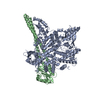
|
|---|---|
| 1 |
|
- Components
Components
| #1: Protein | Mass: 126301.992 Da / Num. of mol.: 1 Source method: isolated from a genetically manipulated source Source: (gene. exp.)  Homo sapiens (human) / Gene: PIK3CA / Cell line (production host): Expi 293F / Organ (production host): KIDNEY / Production host: Homo sapiens (human) / Gene: PIK3CA / Cell line (production host): Expi 293F / Organ (production host): KIDNEY / Production host:  Homo sapiens (human) / References: UniProt: P42336 Homo sapiens (human) / References: UniProt: P42336 |
|---|---|
| #2: Protein | Mass: 83710.281 Da / Num. of mol.: 1 Source method: isolated from a genetically manipulated source Source: (gene. exp.)  Homo sapiens (human) / Gene: PIK3R1 / Cell (production host): Expi-293 / Organ (production host): KIDNEY / Production host: Homo sapiens (human) / Gene: PIK3R1 / Cell (production host): Expi-293 / Organ (production host): KIDNEY / Production host:  Homo sapiens (human) / References: UniProt: P27986 Homo sapiens (human) / References: UniProt: P27986 |
| Has protein modification | N |
-Experimental details
-Experiment
| Experiment | Method: ELECTRON MICROSCOPY |
|---|---|
| EM experiment | Aggregation state: PARTICLE / 3D reconstruction method: single particle reconstruction |
- Sample preparation
Sample preparation
| Component |
| ||||||||||||||||||||||||
|---|---|---|---|---|---|---|---|---|---|---|---|---|---|---|---|---|---|---|---|---|---|---|---|---|---|
| Molecular weight |
| ||||||||||||||||||||||||
| Source (natural) |
| ||||||||||||||||||||||||
| Source (recombinant) |
| ||||||||||||||||||||||||
| Buffer solution | pH: 7.5 | ||||||||||||||||||||||||
| Specimen | Conc.: 0.35 mg/ml / Embedding applied: NO / Shadowing applied: NO / Staining applied: NO / Vitrification applied: YES Details: The sample was purified as a heterodimer and was monodisperse. | ||||||||||||||||||||||||
| Specimen support | Grid material: GOLD / Grid mesh size: 300 divisions/in. / Grid type: UltrAuFoil R1.2/1.3 | ||||||||||||||||||||||||
| Vitrification | Cryogen name: ETHANE |
- Electron microscopy imaging
Electron microscopy imaging
| Experimental equipment |  Model: Titan Krios / Image courtesy: FEI Company | |||||||||||||||
|---|---|---|---|---|---|---|---|---|---|---|---|---|---|---|---|---|
| Microscopy | Model: FEI TITAN KRIOS | |||||||||||||||
| Electron gun | Electron source:  FIELD EMISSION GUN / Accelerating voltage: 300 kV / Illumination mode: FLOOD BEAM FIELD EMISSION GUN / Accelerating voltage: 300 kV / Illumination mode: FLOOD BEAM | |||||||||||||||
| Electron lens | Mode: BRIGHT FIELD / Nominal magnification: 105000 X / Nominal defocus max: 2000 nm / Nominal defocus min: 1000 nm / Cs: 2.7 mm / C2 aperture diameter: 100 µm / Alignment procedure: BASIC | |||||||||||||||
| Specimen holder | Cryogen: NITROGEN / Specimen holder model: FEI TITAN KRIOS AUTOGRID HOLDER | |||||||||||||||
| Image recording | Imaging-ID: 1 / Average exposure time: 2.68 sec. / Electron dose: 60 e/Å2 / Film or detector model: GATAN K3 (6k x 4k)
| |||||||||||||||
| EM imaging optics | Energyfilter name: GIF Bioquantum / Energyfilter slit width: 20 eV |
- Processing
Processing
| EM software |
| ||||||||||||||||||||||||||||||||||||
|---|---|---|---|---|---|---|---|---|---|---|---|---|---|---|---|---|---|---|---|---|---|---|---|---|---|---|---|---|---|---|---|---|---|---|---|---|---|
| CTF correction | Type: PHASE FLIPPING AND AMPLITUDE CORRECTION | ||||||||||||||||||||||||||||||||||||
| Particle selection | Num. of particles selected: 6034364 | ||||||||||||||||||||||||||||||||||||
| Symmetry | Point symmetry: C1 (asymmetric) | ||||||||||||||||||||||||||||||||||||
| 3D reconstruction | Resolution: 3.12 Å / Resolution method: FSC 0.143 CUT-OFF / Num. of particles: 358240 / Details: non-uniform refinement / Num. of class averages: 1 / Symmetry type: POINT | ||||||||||||||||||||||||||||||||||||
| Refine LS restraints |
|
 Movie
Movie Controller
Controller



 PDBj
PDBj




